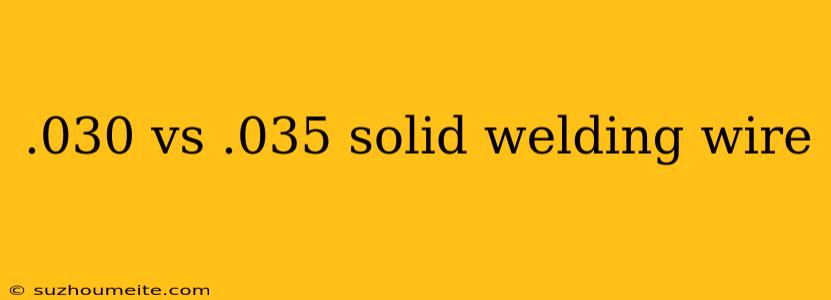.030 vs .035 Solid Welding Wire: Which One to Choose?
When it comes to selecting a solid welding wire for your MIG welding needs, two of the most popular options are .030 and .035. While they may seem very similar, these two wires have some key differences that can affect the quality of your welds and the overall performance of your welding process.
What's the Difference in Diameter?
The most obvious difference between .030 and .035 solid welding wires is their diameter. The .030 wire has a diameter of 0.030 inches (0.76 mm), while the .035 wire has a diameter of 0.035 inches (0.89 mm). This slight difference in diameter may not seem like a lot, but it can have a significant impact on the weld quality and the wire's feeding behavior.
Advantages of .030 Solid Welding Wire
Easier to Feed
The smaller diameter of the .030 wire makes it easier to feed through the welding gun, especially when using smaller guns or when welding in tight spaces. This can result in less wire tangling and kinking, making the welding process smoother and more efficient.
Better for Thin Materials
The .030 wire is better suited for welding thin materials, such as sheet metal or thin tubing. The smaller wire diameter allows for better control and precision when welding these materials, reducing the risk of burn-through or porosity.
Less Heat Input
The .030 wire requires less heat input to achieve a good weld, which can help reduce warping or distortion of the workpiece. This is especially important when welding thin or heat-sensitive materials.
Advantages of .035 Solid Welding Wire
Faster Welding Speeds
The thicker .035 wire can handle faster welding speeds, making it ideal for high-production welding applications. This can help increase productivity and reduce the overall welding time.
Better for Thicker Materials
The .035 wire is better suited for welding thicker materials, such as plate steel or thicker tubing. The larger wire diameter provides more heat input, which can help penetrate thicker materials more easily.
Increased Deposition Rate
The .035 wire has a higher deposition rate than the .030 wire, which means it can deposit more weld metal in a single pass. This can help increase welding efficiency and reduce the number of passes needed to complete a weld.
Choose the Right Wire for Your Needs
Ultimately, the choice between .030 and .035 solid welding wires depends on your specific welding needs and preferences. If you're welding thin materials or need more precision and control, the .030 wire may be the better choice. If you're welding thicker materials or need faster welding speeds, the .035 wire is likely the better option.
Regardless of which wire you choose, make sure to follow proper welding techniques and safety protocols to ensure high-quality welds and a safe working environment.
